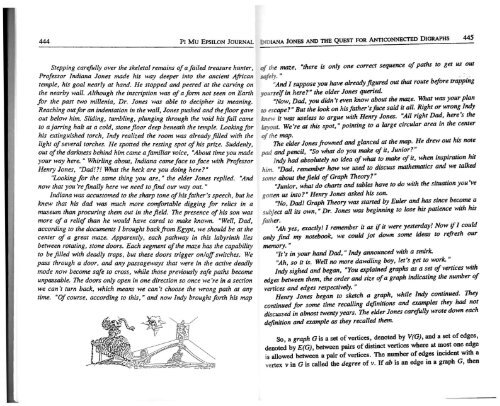Vol. 10 No 6 - Pi Mu Epsilon
Vol. 10 No 6 - Pi Mu Epsilon
Vol. 10 No 6 - Pi Mu Epsilon
- No tags were found...
Create successful ePaper yourself
Turn your PDF publications into a flip-book with our unique Google optimized e-Paper software.
_444 ________________.:.PI.:....::M:.:U:.....:E::.PS::I=L=ON:..:._:J..:O..:U.:.:RN:.::AL:..=<br />
DmiANA JONES AND THE QUEST FOR ANTICONNECTED DIGRAPHS<br />
44S<br />
Stepping carefully over the skeletal remains of a failed treasure hunter,<br />
Professor Indiana Jones made his way deeper into the ancient African<br />
temple, his goal nearly at hand. He stopped and peered at the carving on<br />
the nearby wall. Although the inscription was of a form not seen on Earth<br />
for the past two millenia, Dr. Jones was able to decipher its meaning.<br />
Reaching out for an indentation in the wall, Jones pushed and the floor gave<br />
out below him. Sliding, tumbling, plunging through the void his fall came<br />
to a jarring halt at a cold, stone floor deep beneath the temple. Looking for<br />
his extinguished torch, Indy realized the room was already filled with the<br />
light of several torches. He spotted the resting spot of his prize. Suddenly,<br />
out of the darkness behind him came a familiar voice, "About time you made<br />
your way here. " Whirling about, Indiana came face to face with Professor<br />
Henry Jones, "Dad!! What the heck are you doing here"<br />
"Looking for the same thing you are," the elder Jones replied. "And<br />
now that you're finally here we need to find our way out. "<br />
Indiana was accustomed to the sharp tone of his father's speech, but he<br />
knew that his dad was much more comfortable digging for relics in a<br />
museum than procuring them out in the field. The presence of his son was<br />
more of a relief than he would have cared to make known. "Well, Dad,<br />
according to the documents I brought back from Egypt, we should be at the<br />
center of a great maze. Apparently, each pathway in this labyrinth lies<br />
between rotating, stone doors. Each segment of the maze has the capability<br />
to be filled with deadly traps, but these doors trigger on/off switches. We<br />
pass through a door, and any passageways that were in the active deadly<br />
mode now become safe to cross, while those previously safe paths become<br />
unpassable. The doors only open in one direction so once we're in a section<br />
we can 't turn back, which means we can 't choose the wrong path at any<br />
time. "Of course, according to this," and now Indy brought forth his map<br />
of the maze, "there is only one correct sequence of paths to get us out<br />
safely."<br />
"And I suppose you have already figured out that route before trapping<br />
yourself in here" the older Jones queried.<br />
"<strong>No</strong>w, Dad, you didn't even know about the maze. What was your plan<br />
ro escape" But the look on his father's face said it all. Right or wrong Indy<br />
knew it was useless to argue with Henry Jones. "All right Dad, here's the<br />
layout. We're at this spot, "pointing to a large circular area in the center<br />
of the map.<br />
The elder Jones frowned and glanced at the map. He drew out his note<br />
pad and pencil, "So what do you make of it, Junior"<br />
Indy had absolutely no idea ofwhat to make of it, when inspiration hit<br />
him. "Dad, remember how we used to discuss mathematics and we talked<br />
some about the field of Graph Theory"<br />
"Junior, what do charts and tables have to do with the situation you've<br />
gotten us into" Henry Jones asked his son.<br />
"<strong>No</strong>, Dad! Graph Theory was started by Euler and has since become a<br />
subject all its own," Dr. Jones was beginning to lose his patience with his<br />
father.<br />
"Ah yes, exactly! 1 remember it as if it were yesterday! <strong>No</strong>w if 1 could<br />
only find my notebook, we could jot down some ideas to refresh our<br />
memory."<br />
"It's in your hand Dad," Indy announced with a smirk.<br />
"Ah, so it is. Well no more dawdling boy, let's get to work."<br />
Indy sighed and began, "You explained graphs as a set of vertices with<br />
edges between them, the order and size of a graph indicating the number of<br />
vertices and edges respectively. "<br />
Henry Jones began to sketch a graph, while Indy continued. They<br />
continued for some time recalling definitions and examples they had not<br />
discussed in almost twenty years. The elder Jones carefully wrote down each<br />
definition and example as they recalled them.<br />
So, a graph G is a set of vertices, denoted by V(G), and a set of edges,<br />
denoted by E(G), between pairs of distinct vertices where at most one edge<br />
is allowed between a pair of vertices. The number of edges incident with a<br />
vertex v in G is called the degree of v. If ab is an edge in a graph G, then
















